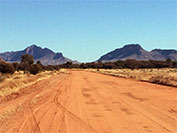
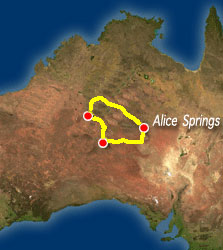
Diamantina Touring Commpany strongly believe in the value of travel insurance. You can purchase NIB Insurance (Australia Limited) policies issued via the link below. You can use this link to purchase travel insurance not only for Diamantina expeditions, but for any travel you want to do anywhere in the world. This insurance is underwritten by XL Insurance Company SE, Australia branch (ABN 36 083 570 441) A Product Disclosure Statement should be considered before acquiring this product..
Its one thing to visit the art galleries in Alice Springs and view the extraordinary vibrancy of Western Desert Aboriginal Art. Its another to travel out into the remote desert country and visit the art centres where this work is created, experience the country where the dreaming originates and the colours of the landscape that inspires the artists. This expedition combines adventure, nature and art and also tells the creation of the Western Desert art movement.
This expedition is of shorter duration than most of our trips, an ideal introduction to remote desert country if you are short on time.
This expedition will take you to remote Aboriginal communities that very few people get to visit. You will meet artists and curators. There will be the opportunity to purchase art from the source at far beter prices than the galleries of Alice Springs or the capital cities.

In 1971 the late Geoffrey Bardon arrived at Papunya in his combi van to teach art. Under his tutelage the artists translated the images they once painted on sand and rock into canvass images .These images represent the Tjukurpa (dreaming) and are an extension of ceremonial expression. Papunya Tula Artists are spread right across the Western Deserts in places like Kiwirrkurra, Haasts Bluff and Kintore. Different areas have developed different styles, the movement is constantly developing.
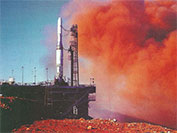
From the early 1950s the entire Western Desert Area became a massive range to test atomic bombs and rockets fired along the centre line of fire from Woomera. Sapper and surveyor Len Beadell was ordered to build a network of roads across the range, some of which we will travel on. Using these roads for access, native patrols rounded up the desert inhabitants and moved them to missions, bores and settlements. This was the origin of towns like Papunya and Yuendemu.

The lands we are travelling on are only accessible by permit. They are freehold lands held in native title. the two land councils we will receive permits for are the Central Land Council and the Nagaanyatjarra Council. The CLC was established in 1975, and the late Charlie Perkins was eleced Chair. The Land Rights Act was legislated in January 1977. CLC manage lands in Central Australia within the Northern Territory. The Ngaanyatjarra Council was formed in 1981 and administers lands and communities on the Western Australian side of the border.
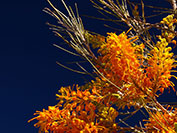
The Western Desert regions are the most remote deserts in Australia, and contain an astonishing diversity of fauna and flora. Travelling on the Aboriginal lands is like travelling through one vast untouched National Park. Stunning pristine country comprising dune fields, rangelands, mountains and woodlands. There are always displays of flowering plants and trees, coupled with the stunning colours of the centre, it is an absolute feast for the eyes, and every evening you will sit around the campfire beneath the stars while your staff cook you a delicious meal on the coals.
We pick up at your hotel at Yulara at 09.00am and travel west through the Uluru Kata Tjuta National Park and into the Western Deserts. We will stop to admire the stunning vistas of the Petermann Ranges, through country of red sandhills and stately desert oaks. In the afternoon we cross the Western Australian border. We camp in view of the ramparts of the Schwerin Mural Crescent.
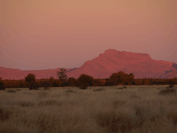
Awake to birdsong and your first morning in the desert. After breakfast we head for the settlement of Warakurna. We will visit Australia’s most remote weather station - Giles Meteorological Station. Built in 1955, Giles is still a fully functioning station, with daily baloon launches. Giles is very much a part of the Western Desert art story, as the Weapons Research Project was responsible for the movement of Aboriginal people away from their traditional lands and into new communities and missions set up across the desert. We will explore this story in detail. We will visit the art gallery at Warakurna Roadhouse. Warakurna Artists were established in 2005. Whilst many of the artists paint Tjukurpa - dreaming stories, there is also a strong figurative movement here, where historical and cultural stories are told in paint. We head to the Sandy Blight Junction road and camp beneath the Walter James Range. We will walk into Bungabiddi Rockhole beneath spectacular red cliffs. There is some Aboriginal rock art to be found on the walls of the gorge.
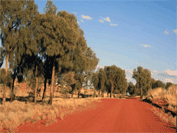
We travel north along the Sandy Blight Junction Road, named by surveyor and road builder Len Beadell. At the Sir Frederick Range we will have vast views of the desert, stretching from the Petermann Ranges across Lake Hopkins all the way to Mt Leisler near Kintore. We will visit some spectacular ancient petroglyphs in a creek bed. We will camp on a clay pan in the Mu Hills.

We continue north along the Sandy Blight Junction road, crossing back into the Northern Territory through impressive stands of Desert Oaks and deep red sand hills. We will lunch beneath the ramparts of Mt Leisler. In the afternoon we will visit Walngurru - Kintore. In the afternoon we head to Sandy Blight Junction, and then north on an Aboriginal business road to camp beside an old native well.

We visit the small isolated community of Nirripi beneath the singular peak of Karku. High on Karku is one of the Western Deserts most sacred ochre mines, hence the location of Nirripi. After visiting the art centre we will travel north to our camp south of Yuendemu.
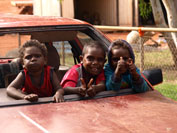
We travel to Yuendemu, and visit the longest running and most successful art centre in Central Australia, Warlukurlangu Artists. Curator and manager Celia Alfonso will not only give us a detailed tour through the gallery, but will also take us to the extraordinary Mens Museum, where some of the earliest examples of Western Desert Art can be seen. In fact, it is argued that the art at the Mens Museum actually predates the famous doors at Papunya. In the afternoon we head south along the Tanami Road to camp in the Western MacDonnel Ranges.
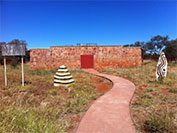
We visit the Papunya Tjupi Art Centre at Papunya, the town where Geoffrey Bardon encouraged the old men to paint. Some believe this was the genesis of the modern western desert art movement. We travel on to Haasts Bluff and visit the Ikuntji Art Centre, before turning east through the Western MacDonnell Ranges National Park to arrive at your hotel in Alice Springs mid to late afternoon.
